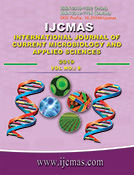


 National Academy of Agricultural Sciences (NAAS)
National Academy of Agricultural Sciences (NAAS)

|
PRINT ISSN : 2319-7692
Online ISSN : 2319-7706 Issues : 12 per year Publisher : Excellent Publishers Email : editorijcmas@gmail.com / submit@ijcmas.com Editor-in-chief: Dr.M.Prakash Index Copernicus ICV 2018: 95.39 NAAS RATING 2020: 5.38 |
Xylanase is an industrially significant enzyme and its production from pure xylan is expensive. The objective of the current study is to utilise sustainable cost effective substrates -coconut oil cake, corn cob, sugarcane bagasse and water hyacinth, for xylanase production. Streptomyces sp. ER1 isolated from the sediments of Cochin estuary was used for xylanase production. The cultural and nutritional conditions for higher xylanase production using the four substrates were optimised using one factor at a time method. Data were analysed by one way ANOVA. The maximum xylanase yield was observed for sugarcane bagasse (10533.33 U/mL), corn cob (7880.9 U/mL) followed by, coconut oil cake (7680 U/mL) and water hyacinth (6930 U/mL) in submerged fermentation. Optimisation studies revealed that optimum fermentation and nutritional factors varied with the substrate. The crude xylanase was vastly effective in deinking of the newspaper at elevated temperature. This study proved that utilising agrowastes provides cost effective and eco-friendly method for xylanase production on large scale. Thus it is an alternative approach to reducing environmental pollution caused due to dumping agro waste. No studies on xylanaolytic activity of actinomycetes from Cochin estuary has been done so far.
 |
 |
 |
 |
 |